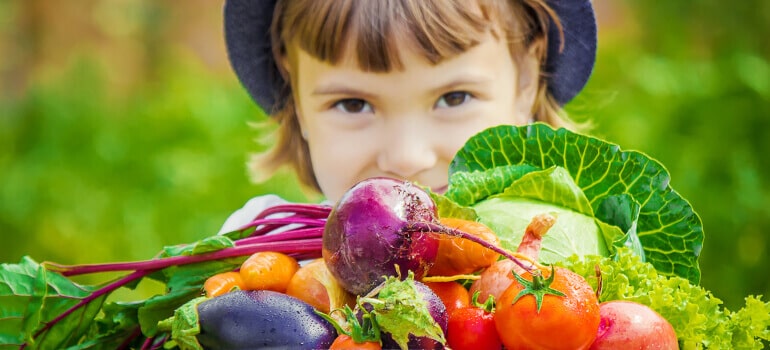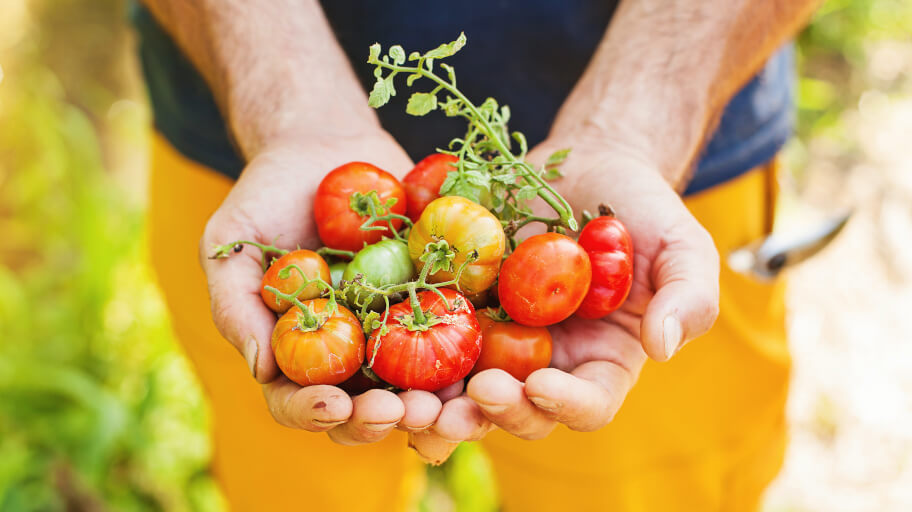
Spending quality time with your kids can be even more fulfilling when you have some special activity planned. If you are debating on what this activity should be, we suggest you consider growing a vegetable garden together.
Okay, that sounds good but what if you don’t know where to start or what to plant? Don’t you worry because our professional gardeners have a tip or two to help you introduce gardening to your kids in a fun and easy way.
What are the benefits of gardening with your kids

This is not just about doing something together as a team but actually helping the little ones develop a set of skills through a memorable experience.
Here is what looking after a garden can do for them:
- Make children more responsible through learning how to care for the veggies.
- Encourage them to spend more time outdoors and enjoy the fresh air.
- Bring the whole family closer while every member contributes to the project.
- Make the kids feel proud of themselves, as they achieve something on their own.
- Show them how valuable and tasty homegrown vegetables are.
How to start the children’s garden

Like every other project, developing a healthy veggie patch with the kids will require some planning. Don’t hesitate to involve the little ones in every step of the process. This will keep them interested and dedicated to the cause from the beginning. It may look like a complicated job but it’s actually pretty simple and anyone can do it.
Here is a step-by-step process to follow for creating a kid-friendly garden.
Pick the perfect location
If these are your first gardening attempts, we suggest you start small. This way your vegetable patch will be easier to maintain and you won’t have to spread yourself too thin. An area that gets plenty of sunlight and has a water source nearby can be qualified as “the perfect location”. The spot also needs to be easily accessible, so you don’t have to worry about your kids’ safety when they are getting to it every day.
Visualise your future garden
The truth is, you can plan the children’s garden in any shape you like. Whether you decide on building a raised bed or directly plant in the backyard, you can do something different than the regular rectangular shape. Use yours and the kids’ imagination to create a home for the veggies that you find unique. Just make sure you consider whether the location you’ve picked allows it.
Excite your children by getting them to draw a garden model on a piece of paper. Hang the picture somewhere visible to remind them of the goal and keep them motivated throughout the whole process.
Choose the right kind of veggies
There are several important factors to consider when selecting your vegetables:
- Growth time – The little ones most likely won’t have much patience to see the fruits of their labour. So, choosing veggies that grow fast is a good idea.
- Production – Think what can give you more for your efforts. Tomatoes and beans, for example, are high-yielding and can produce a lot over a single season. Since they don’t take that much space, they are perfect to grow even if you have a small garden.
- Taste – Think of what your kids like to eat the most but keep in mind that this is also a good opportunity to introduce them to new kinds of vegetables. There is a bigger chance to try them after caring for them.
Start planting
In order to grow healthy plants, you need to be sure that the soil is favourable and rich in nutrients. There are different types of soil and, depending on the types of veggies you are trying to grow, it should be more or less acidic.
One thing is for sure, though, and that’s the need to enrich the soil to help the plants thrive.
Step 1: Composting
You can use compost or chemical fertiliser that’s offered in the specialised stores. While the first consists of recycled organic material, the latter relies on chemicals. Do not use too much of any of them, though, or they could do more harm than good.
Whether you use seeds or seedlings, you need to plant them directly into the soil and NOT cover them with the compost. Instead, spread it around and it will break down.
Step 2: Planting
If you are planting from seeds, definitely check the instruction on the back of the package. It is possible to plant the seeds in pots and look after them indoors until it’s time to move them into the garden. This could be an interesting process for your kids to observe and even document.
In case you plant seeds directly into the garden, you will have to create rows to keep the area organised. Leave enough space between the rows so watering and weeding will be easier for you and the kids. The seeds need to be planted approximately 1-2 cm deep then they have to be covered with soil and watered.
If you decide to use seedlings, the process is pretty much the same. The main difference is the depth needed when planting. This will depend on the size of the root. The bigger the root, the deeper you will have to dig, so there is enough space for further growth. Do not forget to water in the end.
Decorate
Give your kids the freedom to make the space more beautiful. They can decorate with pebbles and stones in different shapes. Drawing cards with the name of the veggies will be fun and helpful since you can use them to mark the different rows. Add some colour by planting edible flowers, too.
What and when to plant in the vegetable garden

Choosing just the right time for planting will guarantee the success of your veggie patch. So, pick carefully, taking into consideration the climate in the part of Australia where you live.
You can find below an exemplary list of the types of herbs and vegetables you can plant and grow in Melbourne with the children throughout the year.
Spring
Lettuce, Carrots, Eggplant, Tomatoes, Cabbage, Basil, Coriander
Summer
Celery, Cucumber, Parsley, Radishes
Autumn
Broccoli, Cauliflower, Beans, Onion, Beetroot, Zucchini
Winter
Turnip, Peas, Swedes, Spinach, Potatoes
In most cases, spring is the best times to start something new like gardening with the kids to produce your very own vegetables. So, do not hesitate to give it a try, as this will certainly be an experience you and the family will not forget. More about what and how to plant in spring in the different parts of Australia you can learn from our Fantastic Spring Planting Guide.








